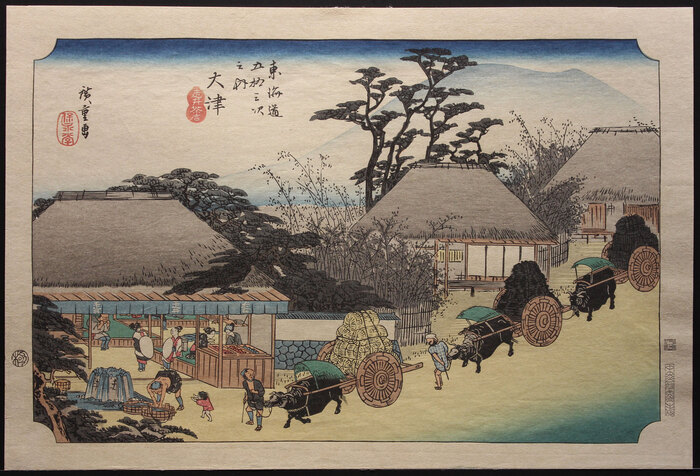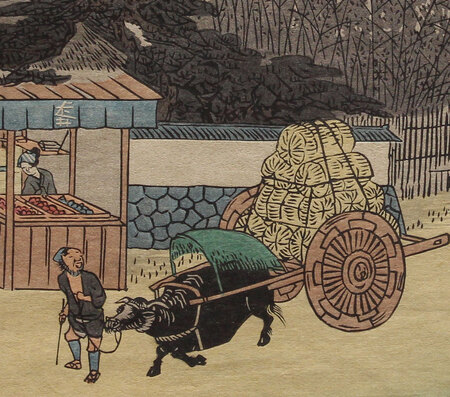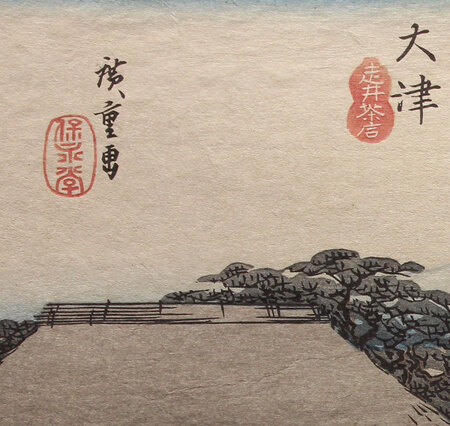Item from the Mokuhankan Flea MarketOtsu - from the 53 Stations of the Tokaido Size: 27.0cm by 40.0cm (10.63 in by 15.75 in) | Enlargement | Shipping Code: [L] ? Designer: Ando Hiroshige Era: Mid Showa | Currency: $ / £ / € Price: ¥ 8,000$ 72.00£ 58.00€ 66.00   Description: This is a print from what is perhaps the single most famous series of Japanese woodblock prints ever produced - "The 53 Stations of the Tokaido", designed by Hiroshige in the 1830s. The print you see here is a reproduction version produced in the post-war period by one of the numerous publishing houses working at that time (Adachi, Takamizawa, Yuyudo, Bijutsu-sha, Yamada Shoin, Kyoto Hanga-in, etc.) Here at Mokuhankan we have a wide selection of such prints, far too many to scan and prepare for the website one by one. We don't always have every print in this series in stock, but try to keep as many of them available as possible. The one you see in this photo is on hand, but feel free to contact us about other designs in this series that you don't see on the site ... Image information: Otsu was the largest town on the Tokaido, as goods from the Sea of Japan side were transported by boat across Lake Biwa, landing here before being transferred to Kyoto, their final destination. Being a village situated between Kyoto and Otsu, many travelers and goods passed through, making it a popular resting spot. In the lower-left corner, you can see a famous well called Hashiri-i, meaning water running well. The abundant and high-quality water from this well was highly valued, and the rice cakes made using this water became known as Hashirii-mochi. Behind the well is a teahouse named Hashirii-jyaya; some people are seen relaxing, presumably enjoying the specialties displayed there. Hiroshige depicted three carts, each pulled by oxen carrying heavy loads - which would appear to be rice and firewood. Because these animals are sensitive to heat, they have been provided with sun shades. The wheels of these heavily loaded carts tended to damage the roads, creating deep ruts that became especially muddy after rain. The resulting difficulty in cart movement annoyed people very much. In the late Tokugawa era, two parallel stone ruts were constructed between Otsu and Kyoto, exactly the width of the cart wheels. These ruts, known as kuruma-ishi (wheel stones), improved traffic flow, and some of these stones are still visible today.  Browse thumbnail pages of various selections from the catalogue ... Mokuhankan Publications:general (105) kacho-e (27) landscape (55) bijin-ga (19) contemporary (18) senshafuda (2) yakusha-e (4) HangaClub (70) ebook (6) miscellaneous (4) 8 Cats (4) supplies (6) [ Also see our Annual Gift Page ] Partner Shops: Kawase Hasui prints (8) Yoshida family prints (37) Doi Hanga prints (14) Miyakodori prints (11) Numabe Mokuhan prints (3) Guest items (18) Mokuhankan Flea Market (All items) general (57) kacho-e (27) yakusha-e (18) landscape (105) bijin-ga (72) kuchi-e (1) contemporary (4) set (37) books (4) [ List of Recently sold items ] [ Flea Market Matsuri ] |
||

